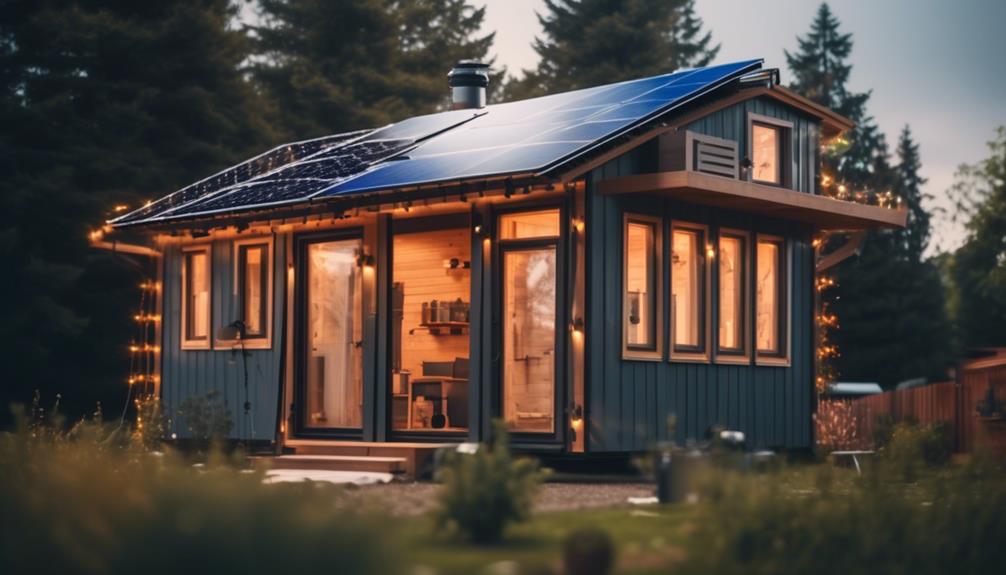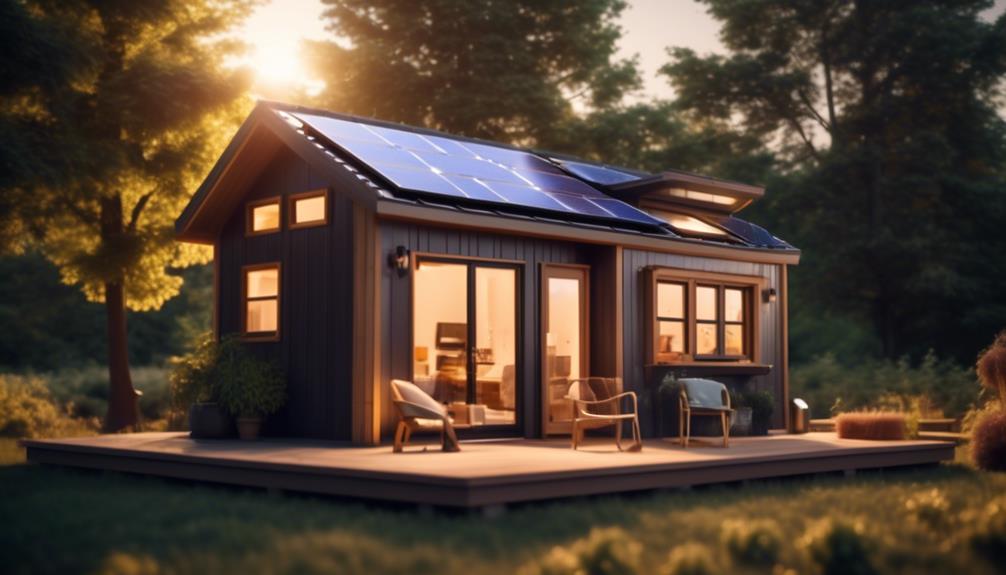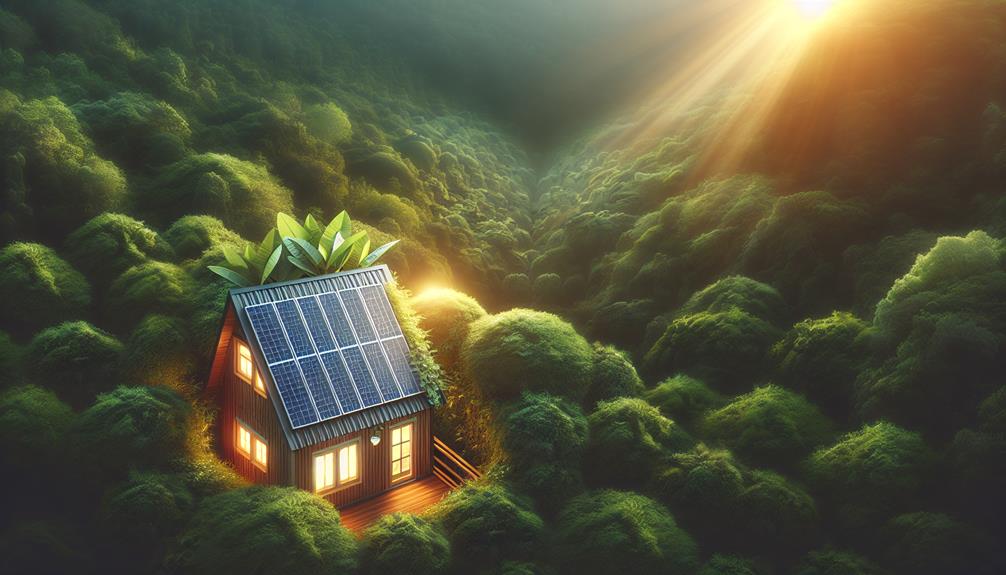It all started with a simple idea: to live in a tiny house and achieve energy independence.
Little did I know that this idea would lead me down a path of discovery and innovation.
As I embarked on this journey, I found myself captivated by the possibilities of solar power.
With each step, from determining the power usage to the installation and wiring of the solar panels, I realized that I was not only reducing my reliance on the grid but also creating a sustainable living environment.
Join me as I unravel the secrets behind achieving energy independence with solar power in a tiny house, and discover the transformative power of harnessing the sun.
Key Takeaways
- Average power usage in a tiny house is around 4 KWs per day, with heating and cooling accounting for approximately 80% of the power usage.
- A typical tiny house can be powered by 15 solar panels, generating around 4,500 watts of power, which covers all power needs, including some heating and cooling.
- Ground mounted solar arrays are recommended for tiny houses, allowing for easier cleaning, snow removal, and shading, and the potential to install up to 4,000 watts of solar panels.
- Opting for a 24 volt system provides flexibility in adding components, allowing for easy expansion of the system without major equipment changes or upgrades.
Power Usage and Solar Panel Needs
Based on the knowledge provided, the power usage in a typical tiny house is around 4 KWs per day, with heating and cooling accounting for approximately 80% of the power usage.
To calculate power requirements, it's crucial to consider other power usage as well, such as the fridge, lights, cell phone, and laptop. Optimizing solar panel placement is essential to ensure maximum power generation.
Tools like a solar path finder can help determine the ideal location for solar panels based on factors like location and tree coverage. Mounting panels on the ground is recommended for tiny houses as it allows for easier cleaning, snow removal, and shading.
Ground mounting also enables the installation of a larger solar panel array, potentially generating up to 4,000 watts.
Mounting and Components of a Solar Panel System
To properly mount and install a solar panel system for a tiny house, it is important to understand the necessary components and consider the best mounting options. The components of a solar panel system include panels, batteries, a charge controller, and an inverter. Solar panels convert sunlight into DC power, which flows to the charge controller. The charge controller regulates the power flow to the batteries or the inverter. Batteries store power for later use, while the inverter converts DC power to AC power for the house. Mounting options for a tiny house solar panel system include ground mounted and roof mounted panels. Ground mounted panels allow for easier maintenance, such as cleaning and snow removal, and offer the potential for a larger solar panel array. On the other hand, roof mounted panels are limited in number due to space constraints but can be more aesthetically pleasing. When it comes to solar panel maintenance, regular cleaning and inspection are necessary to ensure optimal performance. Ground mounted panels make cleaning easier, as they are more accessible, while roof mounted panels may require additional effort for maintenance. Overall, the choice between ground mounted and roof mounted panels depends on the specific needs and preferences of the tiny house owner.
| Components | Function |
|---|---|
| Solar panels | Convert sunlight into DC power |
| Batteries | Store power for later use |
| Charge controller | Regulate power flow |
Installation and Wiring of Solar Panels

Moving on from discussing the mounting and components of a solar panel system for a tiny house, let's now explore the installation and wiring process for the solar panels.
- Calculated ideal location for solar panels
- Built stands for the solar panels
- Installed 250 watt Canadian solar panels
- Wired panels in groups of three, then paralleled into the system
- Built a separate cabinet to house heavy batteries
During the installation process, I carefully calculated the ideal location for the solar panels to maximize sunlight exposure. I then built stands to securely mount the panels in the optimal position.
The 250 watt Canadian solar panels were installed on the stands, and I wired them in groups of three before connecting them in parallel to the system.
To house the heavy batteries, I constructed a separate cabinet, divided into top and bottom sections to prevent gasses from the batteries entering the electrical section. I also installed vents to safely release any gasses from the lead acid batteries and provide adequate ventilation to prevent explosions.
Future Proofing and Wiring of a Solar Panel System
For optimal flexibility and scalability, a key consideration in future-proofing a solar panel system for a tiny house is the choice of a 24-volt configuration. A 24-volt system allows for easy addition of components, such as panels and batteries, without the need for equipment upgrades.
This scalability option provides the opportunity to expand the system for a normal-sized house if desired. Inverters can be stacked for increased scalability as well.
The power flow in the system goes from the breaker panel to the charge controller, then to the interconnect, and finally to the inverter. By choosing a 24-volt configuration, the system can handle the addition of up to 15 panels and more batteries without the need for major equipment changes or upgrades.
This flexibility in adding components ensures that the solar panel system can adapt to future energy needs.
Benefits, Considerations, and Costs of Solar Power

Solar power offers numerous benefits and considerations that should be taken into account when considering its installation in a tiny house.
- Cost savings: Living in a tiny house allows for significant savings on monthly expenses compared to traditional housing. Installing solar panels further reduces or eliminates monthly electricity bills, and the initial investment can be recouped through long-term energy savings. Tax credits and incentives are also available, reducing the overall cost of the system.
- Energy independence: By installing solar panels, tiny house owners can reduce their reliance on the grid and achieve energy independence. This promotes a sustainable living environment and provides a reliable source of renewable energy.
- Equipment efficiencies: When calculating power generation, it's important to consider the efficiencies of the equipment, such as inverters and solar panels. Advances in solar technology have made it more affordable and accessible for tiny house owners.
- Easy scalability: Tiny houses can easily accommodate additional panels and batteries without major equipment changes or upgrades. This allows for future expansion of the system if needed.
- Environmental impact: Solar power is a clean and green energy source, reducing carbon emissions and promoting environmental sustainability. By harnessing the power of the sun, tiny house owners can contribute to a greener future.
Success Stories of Tiny House Solar Power Systems
Living in a tiny house and harnessing the power of solar energy can lead to remarkable success stories of energy independence and sustainable living. Tiny house owners have achieved significant cost savings and reduced their environmental impact by implementing solar power systems.
By generating their own electricity through solar panels, these homeowners have eliminated or greatly reduced their monthly electricity bills. The initial investment in solar panels can be recouped through long-term energy savings, and tax credits and incentives further reduce the cost.
Not only do these systems provide financial benefits, but they also promote a more sustainable lifestyle by reducing reliance on the grid and utilizing renewable energy. Tiny house owners have demonstrated that solar power is a reliable and efficient solution for achieving energy independence and living in a more environmentally-friendly way.
Frequently Asked Questions
What Is the Average Cost of Installing a Solar Panel System for a Tiny House?
The average cost of installing a solar panel system for a tiny house varies depending on the size and complexity of the system. However, it typically ranges from $10,000 to $30,000. Installation time can take anywhere from a few days to a couple of weeks.
How Long Does It Take to Recoup the Initial Investment in Solar Panels for a Tiny House?
It typically takes several years to recoup the initial investment in solar panels for a tiny house. However, with advancements in solar panel efficiency and long-term energy savings, the payback period can be significantly reduced.
Are There Any Maintenance Requirements for Solar Panels in a Tiny House?
Maintenance requirements for solar panels in a tiny house include regular cleaning to maximize efficiency and checking for any damage or loose connections. Common issues faced are debris accumulation and potential shading from nearby objects, which can reduce power production.
Can a Tiny House Solar Panel System Be Expanded in the Future if More Power Is Needed?
Yes, a tiny house solar panel system can be expanded in the future if more power is needed. The scalability of these systems allows for easy addition of panels and batteries without major equipment changes or upgrades.
Are There Any Government Incentives or Tax Credits Available for Installing Solar Panels on a Tiny House?
Yes, there are government incentives and tax credits available for installing solar panels on a tiny house. These incentives can help reduce the cost of installation and make solar power more affordable and accessible for tiny house owners.
Conclusion
In conclusion, my journey towards achieving energy independence with solar power in my tiny house has been nothing short of miraculous.
The sun, my mighty ally, has empowered me to break free from the chains of the grid and embrace a sustainable lifestyle.
With the installation of solar panels and careful consideration of power usage, I've created a harmonious and eco-friendly living environment.
Join me in harnessing the infinite power of the sun and embark on your own extraordinary journey towards energy independence.

